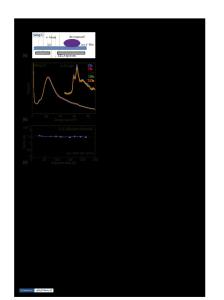In situ studies of ion irradiation effects in an electron microscope
- PDF / 2,963,113 Bytes
- 8 Pages / 613 x 789 pts Page_size
- 60 Downloads / 447 Views
I.
INTRODUCTION
T H E HVEM-Accelerator Facility at ANL is comprised of an AEI EM-7, 1.2 MeV electron microscope and two ion accelerators, a 650 keV NEC and a 2 MeV NEC Tandem accelerator. [1,2] The beams from either accelerator can be directed, through an ion-beam interface, into the specimen chamber of the HVEM. Microscope sample stages allow the sample temperatm'e to be varied from 10 to 1000 K; the sample resistivity can also be monitored in the low-temperature stages. This coupling of an ion accelerator to an electron microscope affords the experimentalist a unique opportunity to perform heavy-ion irradiations and electron microscopy at the same temperature within the same instrument. This permits direct observation of effects such as the buildup of the defect structure as the ion dose is increased; the fate of individual defects as the ion dose is increased; the effect of varying the mobility of the point defects (sample temperature); and irradiation-induced transformations. The potential of this facility will be demonstrated by means of examples. The first example compares the buildup of defects with increasing ion dose at 30 and 300 K in different metals (Cu, Fe, Ni, and dilute Ni alloys). The second considers aspects of the crystalline-amorphous transition induced in the compound semiconductor, GaAs, by ion implantation and the subsequent recrystallization of the amorphous zones. II.
EXPERIMENTAL PROCEDURES
The samples were irradiated as thinned 3-mm transmission electron microscope (TEM) discs. The metal discs were taken from high-purity stock material, vacuum annealed, and then jet electropolished to perforation by using standard solutions. [3] The GaAs, which was obtained from the Morgan Semiconductor Company, Garland, TX, was first mechanically dimpled and then perforated using a chemical polish of sulfuric acid, hydrogen peroxide, and J.S. VETRANO and M.W. BENCH, Graduate Students, and I.M. ROBERTSON, Associate Professor, are with the Department of Materials Science and Engineering, University of Illinois, Urbana, IL 61801. M.A. KIRK, Metallurgist, is with the Materials Science Division, Argonne National Laboratory, 9700 S. Cass Avenue, Argonne, IL 60439. This paper is based on a presentation made in the symposium "Irradiation-Enhanced Materials Science and Engineering" presented as part of the ASM INTERNATIONAL 75th Anniversary celebration at the 1988 World Materials Congress in Chicago, IL, September 25-29, 1988, under the auspices of the Nuclear Materials Committee of TMS-AIME and ASM-MSD. METALLURGICAL TRANSACTIONS A
water in a ratio of 4:1 : 1. Considerable care was taken during sample preparation to ensure that the sample surfaces were free from artifacts that could be mistaken for radiation-induced defects. Surface deterioration was minimized by storing the samples under vacuum prior to and after the irradiation experiments. The samples were irradiated with 50 and 100 keV ions (Ni § Fe § Cu § Ar § Kr § and Xe§ The ion dose rate was typically 101~ions cm -2 s 1, and the ion dose was in the r
Data Loading...










